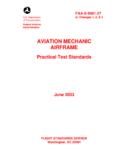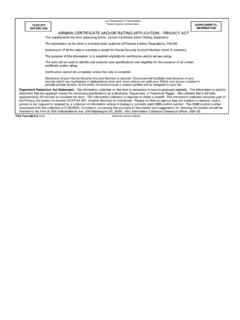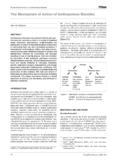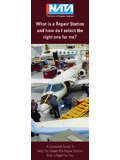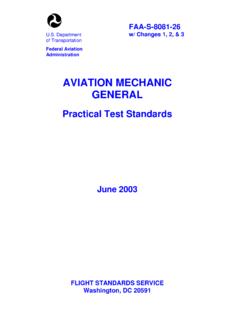Transcription of AIRFRAME&POWERPLANT - Reiff Preheat
1 AOPA PILOT 167 APRIL 2005 Stabilizing your aircraft s oil systemBY STEVEN W. ELLS slowly engines that are started withtoo much throttle not only make aheck of a racket, but also they don tlast very long. Well before the pilot no-tices any sign of problems, valves in-side the engine oil system that protectits components against too-high pres-sures have done their job whichcauses unfiltered oil to be pumpedinto pressure too much is as badas too littleBoth Lycoming and Teledyne Conti-nental Motors engines incorporatesimple systems to control the oil pres-sure within the engine. And each man-ufacturer also equips its engines withat least one other valve to protectagainst the harm caused by too-highoil pressures. Rip Van Winkle didn t awake from his 20-year nap by jumping up and dancing a got up slowly and eased into warmingup those old joints.
2 Rip set a good example forairplane owners. Engines should be warmed up High oil pressure causes minorproblems such as leaks, but the majorproblem is related to oil coolers. For itspopular O-320-series engine Lycomingspecifies that the oil cooler must be ca-pable of withstanding continuouspressures of 150 pounds per squareinch (psi) and a proof pressure of aminimum of 400 psi. These numbersare so far above anything pilots willever see on an instrument panel gaugethat they dismiss these numbers. Yetoil coolers still burst and this is mostoften caused by extreme high-pressurespikes, which occur during cold-weather starts. All oil pumps consist of two mesh-ed gears that revolve inside the pumphousing one gear is driven and it inturn drives the second gear. As theAIRFRAME&POWERPLANTThis sealing surface andspring are typical ofVernatherm valves.
3 Whatisn t typical is the groovein the sealing surface it sextremely BY MIKE FIZER gears rotate, oil drawn from the sumpis forced around the outside of thegears. Before it s circulated to the en-gine one of these valves comes in-to oil from the outlet ofthe pump flows through either the oilscreen or through the engine oil filter these both remove contaminants be-fore the oil goes on to the oil screenassemblies andoil filters have fil-ter bypass does a filterbypass valve do?It keeps oil flow-ing to the engineshould the filteror screen becomeclogged by oil-borne contami-nants. Unlike theslow accumula-tion of choles-terol that clogsheart arteries, the oil-borne contami-nants that clog engine filters andscreens are almost always caused bythe failure of internal engine partssuch as the aluminum wrist pin plugs,or main or connecting rod bearings.
4 When the filter or screen becomesclogged it s guaranteed that the en-gine will fail within a very short timebecause of lubrication distress. Topermit powered flight for those extrafew minutes that pilots always needduring an emergency, the bypassvalve opens, permitting unfiltered oilto circulate until engine no pilot will ever experi-ence an opened filter relief valve be-cause of system contamination. Onthe other hand, it s almost a sure betthat a number of pilots have experi-enced an open filter (or screen) by-pass valve because of a full-throttle-type engine start or the lack of en-gine the oil is cold and the en-gine has not been preheated, thehigh viscosity of the oil unseats thebypass valves and unfiltered oil flowsto the engine. TCM says to Preheat when ambientair temperatures drop below 20 de-grees Fahrenheit.
5 Lycoming says topreheat anytime the temperaturesdrop below 10 degrees F except for theO-320-H-series and the O/LO-360-E-series engines, which need to be pre-heated when temperatures dropbelow 20 degrees F. Many pilots wholive in cold climates believe these lim-its are too low and start preheating at30 or 40 degrees F. Oil-pressure relief valvesThe variation in the speed of the oilpump from idling to full throttle andthe fluctuation of viscosity of the oil be-cause of temperature changes are com-pensated for by the tension on thepressure-relief-valve spring. AOPA PILOT 168 APRIL 2005 AIRFRAME&POWERPLANTA lthough it srelatively rare, oil coolers can bedamaged becauseof OIL COOLER SERVICEA fter the oil passes through the filteror screen the oil-pressure relief valvecontrols the oil pressure.
6 Oil pumpsare always oversized this ensuresthat there will always be a more-than-adequate supply of oil pressure andvolume and the spring-loaded reliefvalve controls engine oil pressure. Thiscan be likened to a hole in the main oilgalley (tube) that is automaticallyopened to vent off too-high hole is opened when the oil pres-sure pushing against the oil side of around steel ball that rests against a ta-pered seat exceeds the pressure ap-plied to the other side of the ball by aspring. Depending on the manufacturer,the oil-pressure relief valve is eitherpart of the oil pump assembly or ismounted on the upper-rear part of theengine case. Engine oil pressure is ad-justed by changing the spring oil pressures may be caused bywear or channeling of the oil-relief-valve seat.
7 These seats can be refaced inthe engine without too much trouble. Oil-pressure relief valves rarelycause any trouble. Occasionally apiece of flotsam gets caught betweenthe ball and the seat; the symptom forthis malady is lower-than-normal oilpressure. But unlike a major engine oroil system failure, the oil temperaturestays steady instead of rising. If thisshould happen, reduce power andland as soon as possible and get therelief valve and oil coolers there s a lot going onOil coolers are also equipped withvalves; these valves, which operatemuch like the thermostat that controlscoolant flow through an automobile ra-diator, automatically control oil flowthrough the cooler. At lower tempera-tures this temperature-controlled valveis retracted this opens a route, allow-ing cold oil to bypass the cooler.
8 Whenthe oil temperature increases to ap-proximately 150 degrees F, a tempera-AOPA PILOT 169 APRIL 2005 One failing of somepilots when they Preheat is to ignorethe oil bulb inside the valve as-sembly often called a Vernathermafter the manufacturer s name willstart to expand toward a tapered seat. At180 to 185 degrees the valve will be fullyseated sealing the bypass route anddirecting the oil through the cooler. Another feature of the Vernathermvalve is a spring that assists the bulb inseating the valve end. This spring hasone other very important job. In theevent of an oil-pressure spike a high-pressure surge this spring will becompressed and the high-pressure oilwill bypass the cooler. One failing ofsome pilots when they Preheat is to ig-nore the oil cooler.
9 This is not alwaystheir fault since popular plug-in-typepreheaters don t always provide a heatsource for oil coolers, especially on Ly-coming engines where the coolers aremost often remote mounted. If the cooler hasn t been preheatedthe Vernatherm valve and seat will bedamaged because of the followingchain of a few minutes of operation,the Vernatherm valve senses warm oiltemperatures and will seat, directingwarm engine oil to the cooler. If thecooler hasn t been preheated, thiswarm oil will run into exceedinglyviscous cold oil in the cooler. If it s re-ally cold, the oil in the cooler will becongealed (solid). When the warm oilbumps up against the congealed oil apressure spike occurs, and the springpressure that seats the valve of theVernatherm will be overcome and thebypass path will open.
10 This immedi-ately lowers the oil pressure and thevalve then slams shut against theseat. This rapid varying of the oilpressure at the cooler will cause thevalve to hammer against the seat, andcan also cause damage to the oil cool-er. In some extreme cases the coolerwill burst. According to Robert Ohnmeiss ofLycoming Engines, this oil-coolerspiking also occurs when the winteri-zation plate is not installed on oilcoolers when outside temperaturesfall. Oil-cooler winterization plates arejust barely on the periphery of mostpilots experience. Without theseplates, oil temperatures never reachthe 180 to 190 degrees that is neces-sary to boil off rust-causing waterwithin the engine. But that s anotherstory for another oil capacities New airplane owners who sidle up tolongtime fliers are often surprisedwhen the graybeards scoff at theirpractice of completely filling their air-plane s oil reservoir.



